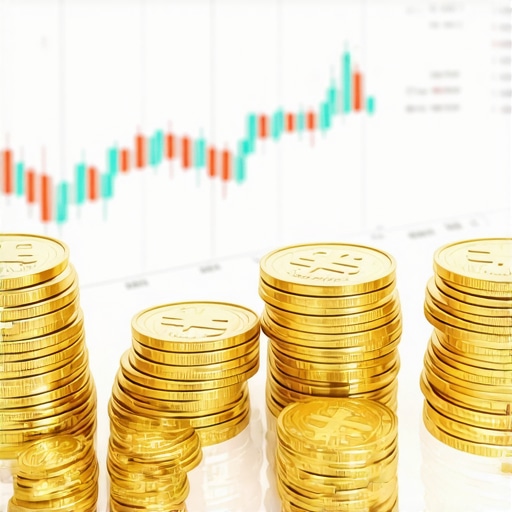Unveiling the Investment Duel: Gold Versus Stocks in Today’s Market
In an era marked by economic uncertainty and rapid market shifts, investors face a timeless question: should one allocate capital into the glittering allure of gold or the dynamic growth potential of stocks? This exploration dives beneath surface-level comparisons to unravel the nuanced realities shaping these two dominant asset classes in 2024. Understanding the interplay between market volatility, inflationary pressures, and global geopolitical tensions is essential to making informed investment decisions that align with both risk tolerance and long-term financial goals.
The Timeless Luster of Gold: More Than Just a Safe Haven
Gold has long been revered as a sanctuary during turbulent economic times, serving as a tangible store of value resistant to currency debasement. Its intrinsic scarcity combined with cultural and industrial demand creates a unique investment profile. Unlike stocks, gold does not generate income streams such as dividends, but its role as a hedge against inflation and currency fluctuations remains unparalleled. Recent central bank acquisitions, notably by emerging market economies, have tightened supply dynamics, potentially enhancing gold’s appreciation prospects (source). Moreover, understanding gold demand trends and supply constraints is crucial for anticipating market movements, as revealed through comprehensive analysis.
Stocks: Engines of Growth Amid Market Fluctuations
Stocks represent ownership in companies and offer potential for capital appreciation and dividend income, making them attractive for wealth accumulation. The stock market’s inherent volatility can be both a risk and an opportunity. Sectors like technology and healthcare have demonstrated robust growth trajectories, but vulnerability to economic cycles remains. Unlike gold, stocks embody company-specific risks and broader market sentiment, demanding vigilant analysis and diversification strategies. For investors seeking exposure to gold through equities, gold mining stocks present a hybrid opportunity combining commodity exposure with corporate growth potential (learn more).
How Should Investors Weigh Gold Against Stocks in a Volatile Economy?
Deciding between gold and stocks involves assessing individual risk profiles, investment horizons, and macroeconomic outlooks. Gold’s stability can offset stock market downturns, yet it may underperform during strong equity rallies. Conversely, stocks offer higher growth but at the cost of increased volatility. Combining these assets can create portfolio resilience. Sophisticated investors often employ strategic asset allocation models, adjusting gold and stock proportions based on economic indicators and personal goals. For those keen on blending stability with growth, exploring gold ETFs and mutual funds offers a balanced pathway (details here).
Navigating Market Nuances: Lessons from Real-World Investment Scenarios
Consider the 2020-2023 period when inflation surged globally. Gold prices rallied as investors sought protection, while stock markets experienced sharp corrections followed by vigorous recoveries. Investors who maintained diversified portfolios, blending physical gold with blue-chip stocks, managed risk effectively. This practical example underscores the value of integrating gold as a hedge rather than viewing it as a standalone investment. Additionally, understanding how central bank gold purchases influence supply and price dynamics can inform timing decisions and portfolio adjustments (read more).
If this exploration piqued your interest, share your thoughts or questions below, and delve deeper with our detailed guides to master gold investing strategies tailored for today’s market.
Reflecting on the Emotional Side of Gold and Stock Investing
Investing isn’t just about numbers and charts; it’s also a deeply personal journey with emotional highs and lows. I’ve often found that gold offers a comforting sense of security, especially during times when stock markets feel like a rollercoaster. The tangible nature of gold – holding a physical bar or coin – creates a psychological anchor that digital stock shares can’t replicate. This emotional stability can actually help keep impulsive decisions at bay, which is crucial when markets get turbulent.
On the other hand, the excitement of watching stocks grow, the thrill of dividends being credited, and the satisfaction of researching promising companies add a different, dynamic dimension to investing. Balancing these emotional experiences has helped me create a portfolio that aligns with both my financial goals and my temperament.
Practical Steps to Integrate Gold and Stocks Effectively
From my experience, one effective strategy is to start by defining your investment horizon and risk appetite. Younger investors might lean more heavily toward stocks for growth, while those closer to retirement may prioritize gold’s stability. Allocating around 10-20% of a portfolio to gold can provide meaningful diversification without sacrificing growth potential. However, this ratio should be adjusted based on evolving market conditions and personal circumstances.
Also, consider the variety of gold investment vehicles available today. Physical gold, while reassuring, requires secure storage solutions. Digital options like gold ETFs or mutual funds can offer liquidity and ease but come with different risk profiles. I’ve found resources like this guide on gold ETFs and mutual funds particularly helpful in navigating these choices.
How Can You Stay Ahead of Changing Market Dynamics Between Gold and Stocks?
This question keeps crossing my mind as markets evolve rapidly with geopolitical shifts and economic data. Staying informed is key. I rely on a mix of trusted financial news, market analysis, and especially understanding supply-demand trends in gold and sector-specific stock movements. For example, central bank gold purchases significantly influence gold’s price trajectory, as detailed by the World Gold Council, which I turn to regularly for up-to-date insights.
Moreover, monitoring macroeconomic indicators such as inflation rates, interest rate policies, and currency fluctuations helps me anticipate potential shifts in gold versus stock performance. Regular portfolio reviews and flexibility to rebalance allocations ensure I’m not locked into outdated strategies.
Sharing Your Journey: What Has Your Experience Been Like?
Investing in gold and stocks is not a one-size-fits-all journey. I’d love to hear about your experiences and strategies. Have you found a blend that works for you? What challenges have you faced balancing these asset classes? Sharing stories and tips can empower everyone navigating this intricate investment landscape. Feel free to comment below or explore our comprehensive posts like how to build a gold investment portfolio for practical advice and deeper understanding.
Leveraging Quantitative Models to Optimize Gold-Stock Allocation
In the quest for portfolio optimization, many sophisticated investors turn to quantitative models that dynamically adjust gold and stock allocations based on evolving market conditions. Techniques such as mean-variance optimization and factor-based investing enable the identification of efficient frontiers where the risk-return tradeoff is finely balanced. Unlike static allocations, these models incorporate variables like volatility clustering, correlations shifts, and macroeconomic indicators, offering a more responsive framework to mitigate downside risk while capturing upside potential.
For instance, incorporating regime-switching models that detect economic cycles can signal when to overweight gold, typically during recessions or inflationary spikes, and pivot back to stocks as growth prospects improve. This adaptive strategy not only enhances diversification but also aligns with empirical evidence showing that gold and stocks exhibit varying correlation coefficients depending on market regimes.
Integrating Alternative Data and Sentiment Analysis for Deeper Insights
Beyond traditional financial metrics, the advent of big data and artificial intelligence has empowered investors to harness alternative data sets and sentiment indicators to refine investment decisions between gold and equities. Social media sentiment analysis, commodity futures positioning, and central bank communications parsed through natural language processing (NLP) provide nuanced signals about investor psychology and market expectations.
For example, analyzing the positioning reports from the Commodity Futures Trading Commission (CFTC) can reveal speculative trends in gold futures, which often precede price movements. Similarly, sentiment shifts detected in earnings calls or geopolitical news can foreshadow sector rotations within equities that impact gold mining stocks differently than broad market indices.
What Role Does Macro-Financial Stress Play in Gold and Stock Correlation Dynamics?
Understanding the impact of macro-financial stress on the correlation between gold and stocks is pivotal for crafting resilient portfolios. Research indicates that during episodes of heightened financial stress—measured by indicators like the VIX volatility index or credit spreads—gold tends to exhibit a negative or near-zero correlation with equities, enhancing its utility as a hedge. Conversely, in stable or bullish markets, this correlation can turn positive, reflecting risk-on sentiment where both asset classes rally simultaneously.
This intricate relationship underscores the importance of monitoring macro-financial stress markers continuously. Institutional investors often deploy stress-testing frameworks to simulate portfolio behavior under various shock scenarios, enabling proactive rebalancing decisions. The World Gold Council’s comprehensive research provides in-depth analysis of these phenomena, offering valuable guidance for expert-level portfolio management.
Harnessing Tax-Efficient Strategies in Gold and Equity Investments
Tax implications can substantially influence net returns, making tax-efficient strategies a critical component in managing gold and stock portfolios. For physical gold holdings, capital gains taxes vary by jurisdiction and holding period, with some investors utilizing tax-advantaged accounts or trusts to defer liabilities. In contrast, equity investments, especially those generating dividends, require careful planning to optimize after-tax income.
Advanced investors may employ strategies such as tax-loss harvesting within stock portfolios to offset gains and utilize exchange-traded funds (ETFs) structured to minimize capital gains distributions. Additionally, investing in gold through ETFs or mutual funds that qualify for favorable tax treatment can enhance overall portfolio efficiency. Consulting with tax professionals familiar with commodity and equity taxation nuances is advisable to tailor strategies to individual circumstances.
Exploring Emerging Trends: Digital Gold and Tokenized Equity Assets
The intersection of blockchain technology with traditional investing has given rise to innovative assets like digital gold tokens and tokenized equities, offering new avenues for liquidity and fractional ownership. Digital gold platforms facilitate instant, secure access to gold ownership without physical custody concerns, while tokenized stocks enable 24/7 trading and global accessibility.
However, these novel instruments introduce considerations around regulatory compliance, counterparty risk, and technological infrastructure. Experts recommend thorough due diligence and an understanding of custodial arrangements before integrating these assets into a portfolio. As this landscape evolves, staying abreast of regulatory developments and technology advancements is imperative for maintaining a competitive edge.
If you’re ready to elevate your investment approach with these advanced strategies and insights, explore our in-depth resources or connect with our experts to tailor a portfolio that navigates the complexities of gold and stock investing effectively.
Decoding the Impact of Geopolitical Shifts on Gold-Stock Synergies
Geopolitical tensions continue to exert a profound influence on the interplay between gold and stock markets, often triggering rapid asset reallocation among sophisticated investors. While gold traditionally acts as a sanctuary during conflicts or trade disputes, equities tend to reflect immediate economic expectations and policy responses. For example, the recent escalation in global trade conflicts has accentuated gold’s role as a crisis hedge, while causing sector-specific volatility in technology and manufacturing stocks.
Understanding the nuanced responses requires analyzing not only headline events but also the underlying market sentiment and central bank communications. This multi-layered approach enables investors to anticipate shifts in asset correlations and adjust portfolios proactively, rather than reactively.
Harnessing Algorithmic Insights to Navigate Gold and Equity Markets
Incorporating machine learning algorithms and quantitative finance techniques offers a cutting-edge advantage for investors managing gold and stock portfolios. Predictive models leveraging historical price patterns, volatility clustering, and macroeconomic indicators can identify subtle regime changes that human analysts might overlook.
Algorithmic trading strategies often utilize dynamic stop-loss levels and momentum indicators tailored to gold’s unique price behaviors versus equities, optimizing entry and exit points. By integrating alternative data such as satellite imagery of mining operations or supply chain analytics, these models enrich decision-making with granular real-world signals.
How Can Portfolio Managers Effectively Utilize Regime-Switching Models to Balance Gold and Stocks?
Regime-switching models empower portfolio managers by detecting shifts between distinct market environments—such as expansion, recession, inflationary spikes, or deflationary phases—each exhibiting characteristic correlations and volatilities between gold and stocks. By dynamically adjusting allocations when regimes change, managers can mitigate drawdowns and capitalize on cyclical opportunities.
For instance, during inflationary regimes, overweighting gold can protect purchasing power, while expansionary phases favor equities for capital appreciation. Implementing such models requires robust data pipelines and rigorous backtesting, making collaboration with quantitative research teams essential.
For an authoritative exploration of regime-switching applications in commodity and equity portfolios, the CFA Institute’s research digest provides comprehensive insights tailored for investment professionals.
Advancing Risk Management Through Stress Testing and Scenario Analysis
Proactive stress testing frameworks enable investors to simulate portfolio performance under extreme but plausible market shocks, such as sudden interest rate hikes, currency crises, or geopolitical escalations. By integrating gold and stocks within these scenarios, one can evaluate the resilience and diversification benefits of combined holdings.
Scenario analysis also facilitates strategic hedging decisions—for example, increasing gold exposure ahead of anticipated central bank tightening or adjusting equity sector weights in response to fiscal policy shifts. These sophisticated approaches demand continuous data updates and cross-asset expertise to remain relevant.
Embracing Sustainable and Ethical Investment Trends in Gold and Equities
Environmental, social, and governance (ESG) considerations are increasingly influencing investor preferences, reshaping how gold and stock investments are evaluated. Responsible gold sourcing, verified through certifications like the Responsible Jewellery Council, increasingly matters to conscientious investors. Simultaneously, ESG-focused equity funds and indices emphasize corporate sustainability and governance standards, often outperforming traditional benchmarks.
Integrating ESG criteria requires detailed due diligence and may involve trade-offs between ethical commitments and financial returns. However, emerging data suggests that sustainability-aligned portfolios can enhance long-term resilience and risk-adjusted performance.
Leveraging Technological Innovations to Enhance Portfolio Transparency
Blockchain-enabled platforms are revolutionizing transparency in gold ownership and equity transactions, providing immutable provenance records and reducing counterparty risks. Tokenization of assets not only democratizes access but also facilitates fractional ownership and real-time settlement, transforming traditional investment paradigms.
Adopting these technologies requires navigating evolving regulatory frameworks and cybersecurity considerations, demanding ongoing education and expert consultation.
What Are the Practical Considerations When Incorporating Tokenized Gold and Stocks Into Traditional Portfolios?
Integrating tokenized assets involves assessing custodial arrangements, regulatory compliance, market liquidity, and technological infrastructure stability. Investors must verify platform credibility, understand smart contract risks, and evaluate how these instruments fit within existing allocation models.
Advisory from specialized fintech consultants and collaboration with legal experts ensure that portfolio integration aligns with fiduciary responsibilities and compliance mandates. Given the nascent nature of this space, continuous monitoring and adaptive strategies are vital for success.
For a detailed primer on tokenized asset incorporation, visit the Investopedia guide on tokenized assets.
Invitation to Engage with Advanced Investment Strategies
These advanced perspectives on balancing gold and stocks underscore the multifaceted nature of modern portfolio management. To deepen your expertise and tailor these insights to your unique investment context, we invite you to connect with our team of seasoned strategists. Engage with exclusive webinars, bespoke portfolio analysis, and cutting-edge research that empower you to navigate the evolving financial landscape with confidence.
Frequently Asked Questions (FAQ)
What are the primary advantages of investing in gold compared to stocks?
Gold serves as a tangible asset and a reliable hedge against inflation, currency depreciation, and geopolitical risks. Unlike stocks, it does not generate income but provides portfolio stability during market volatility. Stocks, conversely, offer growth potential and dividends but are subject to company-specific and market risks.
How does market volatility affect the correlation between gold and stocks?
During periods of heightened financial stress, gold typically has a negative or near-zero correlation with stocks, enhancing its role as a portfolio diversifier. In stable or bullish markets, gold and stocks may exhibit positive correlation, reflecting risk-on sentiment where both asset classes can rise simultaneously.
Can quantitative models improve gold and stock portfolio allocation?
Yes, advanced quantitative techniques like regime-switching models and mean-variance optimization dynamically adjust allocations based on economic cycles and volatility shifts. These models help optimize risk-return tradeoffs by overweighting gold during inflationary or recessionary regimes and favoring stocks during expansion phases.
What role do tax considerations play in managing gold and stock investments?
Tax implications significantly impact net returns. Physical gold may incur capital gains taxes depending on jurisdiction and holding period, while stocks can generate taxable dividends. Strategies such as tax-loss harvesting, investing via tax-advantaged accounts, or using ETFs with favorable tax treatment can enhance tax efficiency.
How is the rise of digital gold and tokenized equities changing traditional investing?
Digital gold tokens and tokenized stocks offer enhanced liquidity, fractional ownership, and 24/7 trading access, transforming traditional barriers. However, they require careful evaluation of regulatory compliance, custodial risks, and technological infrastructure before integration into portfolios.
How do geopolitical events influence the relationship between gold and stocks?
Geopolitical tensions often increase gold’s appeal as a safe haven, while equities may experience sector-specific volatility or broader market declines. Understanding nuanced market sentiment and central bank responses allows investors to anticipate asset correlation shifts and adjust allocations proactively.
What alternative data sources can investors use for better gold and stock market insights?
Alternative data such as social media sentiment, Commodity Futures Trading Commission (CFTC) positioning reports, central bank communications, and satellite imagery provide advanced signals about market psychology, speculative trends, and supply dynamics that traditional metrics might miss.
How can investors incorporate ESG principles into gold and stock portfolios?
Investors can prioritize responsibly sourced gold certified by organizations like the Responsible Jewellery Council and select ESG-focused equity funds emphasizing sustainability and governance. While some trade-offs exist, ESG-aligned portfolios often show enhanced resilience and risk-adjusted returns.
What practical steps should investors take to balance emotional and rational factors when investing in gold and stocks?
Balancing emotional comfort from tangible gold holdings with the dynamic engagement of stock investing helps maintain discipline during volatility. Defining risk tolerance, investment horizon, and portfolio diversification strategies aligned with temperament promotes rational decision-making.
How can stress testing improve risk management in gold-stock portfolios?
Stress testing simulates extreme market scenarios to evaluate portfolio resilience under shocks such as interest rate hikes or geopolitical crises. It guides tactical rebalancing and hedging decisions, ensuring portfolios withstand adverse conditions effectively.
Trusted External Sources
- World Gold Council (WGC): Offers comprehensive research on gold market dynamics, demand-supply trends, and risk-hedging strategies essential for understanding gold’s role in portfolios.
- CFA Institute Research Foundation: Provides authoritative insights on quantitative models, regime-switching strategies, and advanced asset allocation techniques relevant to gold and equity investments.
- Commodity Futures Trading Commission (CFTC): Publishes positioning reports and market data crucial for analyzing speculative trends and futures market behavior in gold and related assets.
- Responsible Jewellery Council (RJC): Sets standards and certifications for ethical gold sourcing, informing sustainable investment decisions in precious metals.
- Investopedia: Offers detailed primers on emerging investment technologies like tokenized assets, helping investors navigate regulatory and operational considerations.
Conclusion
In the complex investment landscape of 2024, balancing gold and stocks demands a nuanced understanding of their distinct attributes, market behaviors, and evolving technological and geopolitical influences. Gold’s enduring appeal as a safe haven complements the growth potential and income generation of equities, creating diversified portfolios that can weather volatility and inflationary pressures.
Integrating advanced quantitative models, alternative data analytics, and tax-efficient strategies further refines allocation decisions, while embracing ESG principles and digital innovations positions investors at the forefront of sustainable and accessible investing. Ultimately, blending emotional resilience with rigorous analysis empowers investors to craft portfolios aligned with their unique goals and risk profiles.
We invite you to share your insights, explore our expert resources, and apply these sophisticated approaches to enhance your investment journey with gold and stocks.










